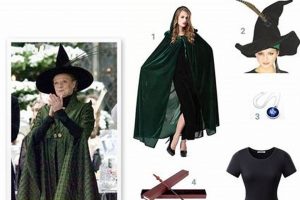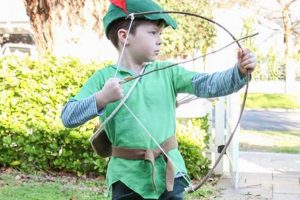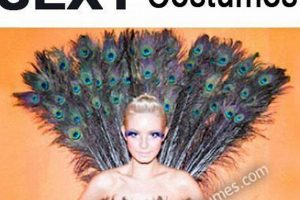Creating a squirrel-themed outfit oneself is an approach to costuming that emphasizes personalization and resourcefulness. This method involves utilizing readily available materials and crafting techniques to replicate the appearance of a squirrel. An example includes fashioning a bushy tail from faux fur and attaching it to a brown garment, along with designing ear-shaped headwear.
This approach to costuming offers several advantages. It allows for cost savings compared to purchasing pre-made costumes, encourages creativity and skill development, and provides the opportunity to create a unique and individualized product. Historically, this type of do-it-yourself garment creation has been a common practice, stemming from periods of resource scarcity or a desire for self-expression.
The subsequent sections will detail specific methods and materials for crafting various components of such an outfit, offering guidance on achieving a realistic and appealing final result. Considerations will be given to both simple and more advanced techniques to accommodate different skill levels.
Tips for Creating a Squirrel-Themed Outfit
The following tips provide guidance for constructing a successful squirrel-themed outfit, emphasizing realism, durability, and wearer comfort.
Tip 1: Tail Construction: Focus on achieving a realistic tail shape. Employ wire framing within the faux fur to allow for posing and prevent sagging. Secure the tail attachment point to the garment to distribute weight evenly.
Tip 2: Color Palette: Research accurate squirrel coloration. Utilize varying shades of brown, gray, and red to replicate natural fur patterns. Consider using fabric dye or paint sparingly for subtle highlights and shadows.
Tip 3: Ear Design: Construct ears that maintain their upright shape. Stiff interfacing or felt can provide necessary structure. Ensure the ears are securely attached to a headband or hat for stability.
Tip 4: Facial Detailing: Enhance the outfit with subtle facial features. Consider using face paint or makeup to create whiskers and slightly darkened areas around the nose and eyes.
Tip 5: Material Selection: Prioritize materials that are both comfortable and durable. Fleece, felt, and faux fur are commonly used. Consider the climate in which the outfit will be worn when selecting fabric weight.
Tip 6: Secure Attachments: All components of the squirrel outfit should be securely attached to the base garment. Utilize strong adhesives or stitching to prevent detachment during wear.
Tip 7: Maintain Proportions: When sizing the individual components of the outfit, such as the tail and ears, maintain realistic squirrel proportions. These details contribute significantly to the overall aesthetic of the costume.
Adhering to these tips will enhance the quality and authenticity of the homemade squirrel outfit, resulting in a more convincing and enjoyable final product.
The concluding section will summarize the core concepts of this process.
1. Tail realism
Tail realism is a crucial factor influencing the overall success of a homemade squirrel costume. A convincing tail enhances the visual impact of the costume and contributes significantly to its recognizability. Its appearance must closely emulate the natural characteristics of a squirrel’s tail.
- Shape and Structure
The tail’s shape should accurately reflect that of a squirrel’s tail, typically bushy and somewhat flattened. Internal structure, achieved through wiring or other supportive materials, is necessary to maintain the desired shape and prevent the tail from appearing limp or disproportionate. Improper shaping detracts from the authenticity of the costume.
- Material Selection
The choice of material directly affects the realism of the tail. Faux fur is a common choice due to its ability to mimic the texture and appearance of real fur. The length, density, and color of the faux fur should be carefully selected to match the characteristics of a squirrel’s tail. Inadequate material selection compromises the visual fidelity of the costume.
- Color and Pattern
Squirrel tails exhibit variations in color and pattern, often featuring gradients or subtle stripes. Replicating these nuances through careful selection of fabric colors or the application of dyes enhances realism. A monochromatic or poorly colored tail lacks the depth and complexity found in natural examples.
- Attachment Method
The method of attaching the tail to the costume is integral to its realism. The tail should be securely fastened to the garment in a manner that appears natural and does not impede movement. Improper attachment can result in the tail appearing awkwardly positioned or detached from the body of the costume.
Each of these facets plays a critical role in achieving a convincing squirrel costume. A well-executed tail, characterized by accurate shape, appropriate material, realistic color patterns, and secure attachment, elevates the overall quality of the project, enhancing its impact and believability. Conversely, shortcomings in any of these areas diminish the effectiveness of the final product.
2. Ears construction
Ears construction is a significant determinant in the overall aesthetic and recognizability of a self-made squirrel outfit. The fidelity of the ears’ design and fabrication directly impacts the costume’s perceived realism and effectiveness. Accurate depiction of squirrel ears involves considerations of shape, size, material, and attachment method. Deficiencies in ears construction detract from the costume’s verisimilitude, potentially undermining the intended resemblance. For instance, ears that are too small, improperly shaped, or lacking in structural integrity can render the costume unconvincing. Conversely, well-executed ears significantly contribute to a successful visual transformation.
Practical application of ears construction principles involves several key steps. Initially, precise measurements of the wearer’s head are necessary to determine appropriate ear size and placement. Common materials include felt, foam, and faux fur, each offering distinct advantages in terms of texture, flexibility, and durability. The chosen material must be sufficiently rigid to maintain the desired ear shape while remaining comfortable for the wearer. Attachment methods vary depending on the base garment, with options including headbands, hats, or direct attachment to a hood. Ensuring a secure and stable attachment is crucial to prevent the ears from shifting or falling off during wear.
In summary, effective ears construction is not merely an ancillary detail but a fundamental component of any successful squirrel-themed outfit. Challenges in ears construction often stem from difficult
ies in achieving realistic shapes or ensuring secure attachment. Addressing these challenges through careful planning, appropriate material selection, and precise fabrication techniques is essential to realizing the intended transformative effect. Ultimately, well-crafted ears contribute significantly to the overall impact of the self-made squirrel costume.
3. Color accuracy
Color accuracy is a pivotal aspect in self-made squirrel attire, significantly influencing the costume’s visual fidelity and believability. Inaccurate colors detract from the desired realism, potentially misrepresenting the animal and reducing the costume’s overall effectiveness.
- Species-Specific Variations
Different squirrel species exhibit distinct color variations in their fur. Eastern gray squirrels, for example, are predominantly gray with hints of brown, while red squirrels display a reddish-brown coat. A homemade costume must accurately reflect the color palette of the specific squirrel species being portrayed to achieve a realistic representation. A generalized brown color may not suffice for portraying a specific subspecies with unique coloration. Omitting this level of detail detracts from the authenticity.
- Seasonal Changes
Some squirrel species undergo seasonal changes in fur color. Gray squirrels, for instance, may develop a more reddish hue during the winter months. Accurately depicting these seasonal variations in a homemade costume requires careful attention to color selection and potentially the use of multiple fabric colors or dyeing techniques. Failure to acknowledge seasonal color changes results in a less nuanced and less accurate portrayal.
- Color Distribution and Patterns
Squirrel fur often exhibits complex patterns and color distributions, including darker dorsal stripes or lighter ventral regions. These patterns contribute to the animal’s camouflage and visual distinctiveness. A homemade costume should attempt to replicate these patterns through careful fabric selection, dyeing, or painting techniques. Neglecting the accurate distribution of colors can result in a flattened and less convincing appearance.
- Material Color Consistency
Achieving color accuracy also depends on selecting materials with consistent color throughout. Variations in dye lots or fabric finishes can introduce inconsistencies that detract from the costume’s realism. Thorough inspection of materials and, if necessary, dyeing fabrics to achieve a uniform color is essential. Inconsistencies in color undermine the overall visual coherence of the costume.
The connection between these facets underscores the importance of meticulous color research and careful material selection in crafting squirrel costumes. Attention to species variations, seasonal changes, pattern replication, and material consistency directly contributes to the costume’s believability. A well-executed color scheme elevates the garment from a simple costume to a recognizable representation, enhancing its impact.
4. Material suitability
Material suitability is a critical determinant in the quality, durability, and overall success of any do-it-yourself squirrel costume. The selection of appropriate materials dictates the costume’s comfort, aesthetic appeal, and long-term viability. Understanding the properties and limitations of various materials is essential for crafting a convincing and functional outfit.
- Fabric Texture and Appearance
Fleece, felt, and faux fur are commonly used materials for squirrel costumes. Each offers a distinct texture and visual aesthetic. Faux fur mimics the appearance of animal fur, enhancing realism, but can be more expensive and challenging to work with. Fleece offers comfort and ease of manipulation but may lack the desired visual texture. Felt is inexpensive and versatile but may not provide the desired level of realism or durability. Selecting the appropriate fabric texture is essential for achieving the desired appearance.
- Durability and Longevity
The selected materials must withstand the stresses of wear and tear. Costumes intended for repeated use require durable fabrics and secure construction techniques. Lightweight fabrics may be suitable for single-use costumes but are prone to damage. Reinforcing seams and stress points with sturdy stitching enhances the costume’s longevity. The fabric selection will determine the lifespan of the costume.
- Comfort and Breathability
Costume comfort is paramount, particularly for costumes intended for extended wear or use in warm environments. Breathable fabrics such as cotton or linen can be incorporated into the costume’s lining to improve airflow and reduce overheating. Synthetic fabrics may trap heat and moisture, leading to discomfort. Material selection impacts the wearer’s experience and comfort level.
- Cost and Availability
Budgetary constraints often influence material selection. Inexpensive fabrics may be suitable for cost-conscious projects, but may sacrifice quality and appearance. Readily available materials simplify the construction process and reduce project timelines. Balancing cost, availability, and quality is essential for successful resource management.
Material suitability, therefore, necessitates a comprehensive evaluation of fabric texture, durability, comfort, and cost. The careful selection of appropriate materials directly impacts the outcome of a do-it-yourself squirrel costume, ensuring a balance of realism, functionality, and economic feasibility. Poor choices in this area negatively impacts longevity of costume.
5. Attachment security
In the context of creating a squirrel-themed outfit, the solidity of the fastenings linking costume elements is paramount to the overall success and functionality. Compromised attachment security can lead to detachment of key components such as the tail, ears, or other accessories. This not only detracts from the visual integrity of the costume but also presents potential safety hazards, especially in environments with high levels of activity. Strong and reliable attachment methods are therefore crucial.
A primary example illustrating this significance is the attachment of the tail, a critical element of the squirrel costume. If the tail attachment is weak or improperly secured, it may detach during movement, compromising the costume’s intended appearance. This necessitates utilizing sturdy sewing techniques, industrial-strength adhesives, or robust fastening mechanisms to ensure the tail remains firmly affixed. Further practical application includes reinforcing attachment points with additional fabric layers or using hidden stitching to enhance durability and prevent visible wear.
In conclusion, attachment security is not merely a superficial consideration in creating a squirrel costume but a fundamental requirement for its structural integrity and usability. Properly secured attachments contribute to the costume’s overall aesthetic appeal, enhance its durability, and minimize the risk of component failure during wear
. Mastering robust attachment methods is a vital skill for those engaged in costume construction, ensuring both visual fidelity and user safety.
6. Proportion balance
In the construction of a homemade squirrel costume, adherence to accurate proportional relationships is a critical factor influencing the overall realism and aesthetic appeal. The relative sizes of various costume componentstail, ears, bodymust reflect those of a genuine squirrel to create a convincing and visually harmonious representation.
- Tail-to-Body Ratio
The tail of a squirrel constitutes a significant portion of its overall length. In costume construction, a tail that is disproportionately small or large in relation to the body section will detract from the realism. Accurate measurement and scaling are essential. For example, if the body section of the costume is 36 inches long, the tail should approximate 18-24 inches, depending on the specific squirrel species being emulated. Failure to adhere to this ratio results in a visually distorted and less convincing outcome.
- Ear-to-Head Size
Squirrel ears are proportionally large relative to their head size, contributing to their alert and expressive appearance. Ears that are too small will make the costume appear less squirrel-like, while ears that are excessively large may appear cartoonish or ungainly. Achieving accurate proportion requires careful consideration of the wearer’s head size and the intended aesthetic. An adult-sized costume, for example, typically requires ears in the range of 4-6 inches in height. Disregarding this consideration diminishes the costume’s authenticity.
- Limb Length and Thickness
The length and thickness of the limbs in a squirrel costume should reflect the animal’s agile and athletic build. Disproportionately short limbs may appear awkward, while excessively long limbs may impede movement and create an unnatural silhouette. The diameter of the arms and legs in the costume should correlate with the overall body size to maintain visual harmony. Inconsistent limb proportions compromise both the costume’s appearance and its functionality.
- Facial Feature Scale
If the costume incorporates facial features, such as a nose or whiskers, their size and placement must align with the overall head size. Disproportionately large or small facial features will detract from the costume’s realism. The scale of these features should be carefully considered in relation to the wearer’s face and the intended level of detail. Imbalanced facial feature proportions can create an unsettling and unrealistic appearance.
Ultimately, adherence to proportional balance is a key indicator of quality in homemade squirrel costumes. Meticulous attention to the relative sizes of various components ensures a visually harmonious and believable representation of the animal, elevating the costume from a simple garment to a compelling and recognizable work.
Frequently Asked Questions
The following section addresses common inquiries regarding the creation of squirrel-themed costumes, providing detailed information to guide the construction process.
Question 1: What materials are most suitable for crafting a realistic squirrel tail?
Faux fur, selected for its resemblance to natural fur texture, is a primary material. The addition of flexible wire within the tail structure enables shaping and prevents sagging. Batting or stuffing can be used to achieve desired volume.
Question 2: How can accurate squirrel ear shape and structure be achieved?
Stiff felt or interfacing, cut to the appropriate ear shape, provides structural support. Fabric glue or stitching secures the felt to an outer fabric layer. The ear base is then attached to a headband or hat for secure placement.
Question 3: What methods can be employed to replicate realistic squirrel coloration?
Multiple shades of brown, gray, and red faux fur or fabric can be combined to mimic natural squirrel fur patterns. Fabric dye can be applied sparingly to add subtle highlights and shadows. Reference images of the target squirrel species are crucial for accurate color representation.
Question 4: How can durability and longevity be ensured in a homemade squirrel costume?
Selecting high-quality fabrics, reinforcing seams with durable stitching, and utilizing strong adhesives for component attachment are essential. Stress points, such as attachment areas for the tail and ears, require additional reinforcement.
Question 5: What safety considerations should be observed during costume construction and wear?
Non-toxic adhesives and dyes should be used to prevent skin irritation. Ensure adequate visibility when wearing the costume, particularly if a mask or headpiece is involved. Avoid using small, detachable parts that could pose a choking hazard.
Question 6: How can a balance between realism and comfort be achieved in a squirrel costume?
Prioritize lightweight, breathable fabrics for the costume’s base layer. Avoid overly restrictive designs that limit movement. Consider the climate in which the costume will be worn and select fabrics accordingly. Balance the desire for realistic detail with the need for wearer comfort.
Successful completion of a homemade squirrel costume hinges upon careful material selection, meticulous construction techniques, and diligent attention to detail. Prioritizing both realism and functionality is crucial for achieving a satisfactory outcome.
The following section will provide instructions for making a squirrel costume tail.
Conclusion
The foregoing has detailed fundamental principles in squirrel costume diy, emphasizing realistic construction, material selection, and secure assembly. Key aspects such as tail realism, ear construction, accurate coloration, suitable materials, attachment security, and proportional balance directly influence the final product’s success. Attention to these elements yields a convincing and durable garment.
Effective application of these techniques requires careful planning and execution. Skilled crafting elevates the costume from a simple imitation to a compelling representation. A well-executed homemade squirrel costume offers not only a visual transformation but also an opportunity for creative expression and resourcefulness.







![Easy DIY Police Costumes: Tips & Ideas [Budget-Friendly] The DIY Hub: Creative Crafts, Repairs & Life Hacks Easy DIY Police Costumes: Tips & Ideas [Budget-Friendly] | The DIY Hub: Creative Crafts, Repairs & Life Hacks](https://craftingdiycenter.com/wp-content/uploads/2025/07/th-7319-300x200.jpg)